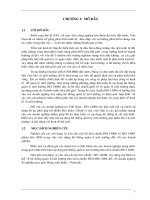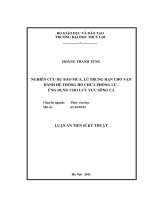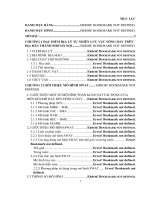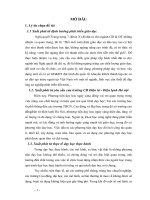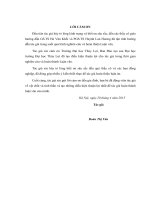Xây dựng mô hình toán vận hành hệ thống hồ chứa đa mục tiêu thời kỳ mùa kiệt cho lưu vực sông ba tt tiếng anh
Bạn đang xem bản rút gọn của tài liệu. Xem và tải ngay bản đầy đủ của tài liệu tại đây (840.51 KB, 33 trang )
1
DISSERTATION OVERVIEW
1. The necessity of the research
In recent decades, many reservoirs have been built around the
world including Vietnam. Vietnam is a country with many reservoirs
that serve different purposes from irrigating agriculture to generating
electricity. However, until now, there is no exact solution for how to
operate the reservoir system to obtain the maximum benefits to
society.
Numerical modeling is an effective tool for water management
in river basins. It is well known that MIKE-BASIN, MIKE11, HECRESSIM, WEAP, HEC-HMS ... models are widely used in the world.
These models have also been used in water planning and
management for river basins in Vietnam, including the Ba river
basin. Each model has its own advantages and also and certain
limitations, especially when they are applied in specific research
conditions. Therefore, the researchers around the world continue to
develop and improve them. In this thesis, on the basis of based on
approaching and inheriting existing studies, the author chooses the
research topic: "Building a mathematical model to operate multipurpose reservoir system in dry season for Ba river basin"
2. Subject and scope of the research
The result is carried out on a multi-purpose reservoir system in
the Ba river basin. The operation process is considered during the dry
season for the large reservoirs on the mainstream. This study also
takes into account the regulation of irrigation water supply for all
small reservoirs on the system.
3. Objectives of the research
2
3.1. Overall objectives
The goal of this study is to develop a model for operating interreservoir system during dry season to help support operational
decisions for inter-reservoir systems in the Ba river basin.
3.2. Specific objectives
Build a model that meets the requirements:
4. Research methodology
In this thesis, the author has used the methods including
inheritance method; mathematical modeling method, and experiment
method.
5. Scientific and practical significance of the dissertation
The author has developed a simulation model with the integration
of rain-flow model. This model is capable of calculating and
forecasting the incoming flows into reservoir system. This is a new
contribution that will contribute to the development of the
methodology in the research and operation of multi-purpose reservoir
systems.
The research on operation techniques for real-time reservoir
regulation will be the scientific basis for improvement of existing
operating procedures. This model can be applied to the forecasting of
flow and safe operation during dry season in the Ba river basin.
6. The Scientific approach
The thesis approaches in the direction of building a model to
operate the inter-reservoir system in the dry season, capable of
supporting operation decisions.
7. The new contributions
3
1. Developed a potential water reduction graph in the dry
season for the main reservoirs in the Ba river basin as a basis
for identifying dry season flows. After that, plan of water use
and operation of reservoirs system were presented;
2. Developed a Ba model which integrates the rain - flow
model, water balance model and reservoir regulation to serve
water management and decision-making for reservoir
operation in Ba river basin in dry season;
3. Built operation techniques for real-time reservoir regulation
in the Ba river basin based on the analysis and calculation of
water storage at the end of the rainy season and water change
in river during dry season. In addition, a reasonable operation
regime is proposed to ensure the safety of water supply and
improve the efficiency of reservoir operation in the dry
season. This is the basis for the additional study of the interreservoir operation procedure that has been issued.
8. The thesis structure
In addition to the overview, conclusion and recommendations parts,
the thesis consists of 4 chapters:
-
Chapter 1: Literature review of studies on reservoirs
operation in dry season.
-
Chapter 2: Scientific and practical basis to set up the problem
of reservoir operation in real-time in dry season for Ba river.
-
Chapter 3: Setting up simulation model for forecasting and
operating the reservoir system in real-time for Ba river.
-
Chapter 4: Study on reservoir operations in dry season for Ba
river basin.
4
5
CHAPTER 1. LITERATURE REVIEW OF STUDIES OF
RESERVOIRS OPERATION IN DRY SEASON
1.1. Role of reservoir system in water balance
Reservoirs can be considered as the main solution in the
development plan of surface water sources. A reservoir is considered
as a node of the system and is built with the purpose of changing the
flow on the system in accordance with the task of exploiting the
water source.
1.2. Overview of studies on reservoirs operation
1.2.1. Overview of reservoir operation studies in the world
There are many researches on operations of independent
reservoirs as well as multi-reservoir systems and using different
control algorithms. These studies can be divided into two main
groups including optimization and simulation methods.
1.2.2. Overview of reservoir operation studies in Vietnam
In Vietnam, there are several studies on reservoirs operation.
The researchers studied solutions to operate single and multi-purpose
reservoirs. These studies are considered as a scientific and practical
basis to help authorities issue reservoir operation procedures.
1.2.3. Studies in the Ba river basin
Reasonable management and effective use of water in the Ba
river basin is a complex problem that has been studied in several
projects and scientific topics.
1.3. Comments on studies on reservoirs operation and
determination of research topic
1.3.1. Methodology
Currently, studies on reservoir operation include 2 main groups:
Optimization method and simulation method.
6
1.3.2. Research situation of reservoir operation in Ba river basin
To the best of the author’s knowledge, the water resources
management and real-time operation in the dry season for the
reservoir system in the Ba river has not been studied in detail.
1.3.3. Orientation on thesis topics
The author will develop a model to operate the inter-reservoir
system in the dry season, which has ability to support operational
decisions, applied to the Ba river basin as a case study. The model
will be built based on inheriting the methodology of existing models
and overcome the limitations that make it difficult to use in the
operation of the inter-reservoir system.
1.4. Topic suggestions for thesis
From the problem in reservoir operations in Ba river basin, the
author will study and propose a "reasonable" operation plan. The
method of system simulation and real-time operation model will be
the main content in this thesis. The operation plan is called
“reasonable” when it both improves the downstream water supply
and also does not affect the ability to generate electricity.
7
CHƯƠNG 2: SCIENTIFIC AND PRACTICAL BASIS TO
SET UP THE PROBLEM OF RESERVOIR OPERATION IN
REAL-TIME IN DRY SEASON FOR BA RIVER
2.1. Geographic limit of the Ba river basin
The study area includes the administrative boundaries of 26
districts and cities. Natural area is 16,471 km2.
2.2. River characteristics
There are 36 tributaries (level I), 54 tributaries (level II) and 14
tributaries (level III) in the Ba river basin.
2.3. Analysis of climatic characteristics and river flows affecting
to the reservoirs operation regime during the dry season
2.3.1. Climate characteristics
The Ba river basin is strongly influenced by the two types of
monsoon winds in the east and west of Truong Son range.
2.3.2. Rainfall characteristics
The distribution of the rainy season in a year is strongly
influenced by the climate in the West and East of Truong Son range
as well as and the terrain characteristics of the basin.
2.3.3. Flow regime characteristics
In the Ba river basin, the changes in seasonal flows are quite
complex, except for the flows in the Hinh river and other small
tributaries in the lower river basin).
2.3.4. Characateristics of water reduction graph in dry season
2.3.4.1 The water reduction graph in dry season
The process of gradual reduction of flow at the end of a rain is
defined as the water reduction graph. If there is no rain in the next
period, the water reduction graph will be reduced steadily. At the
beginning of the dry season, the flow in the river will gradually
8
decrease until the end of the dry season. If during the dry season
there is a heavy rain that exceeds the permeability of the soil, the
water reduction graph will have local increase points. However, this
process usually occurs in a very short time and the water reduction
graph quickly returns to the general form because the reserve of
groundwater does not increase much. Drawing curves when ignoring
some mutations due to rain effects in the dry season, we get a smooth
curve continuously decreasing named “potential water reduction
graph".
The potential water reduction graph is generated from the
measured data of reservoirs: An Khe reservoir has real data measured
from year (1979-2010), Ayun Ha (1989-1992), Krong H'Nang (1979,
1989, 2003-2008, 2012 - 2018) and Song Hinh (1978-1995, 19992014).
Discharge, Q(m3/s)
250
1981
1984
1987
1990
200
1993
1996
1999
2002
2005
2008
2011
150
100
1982
1985
1988
1991
1994
1997
2000
2003
2006
2009
1983
1986
1989
1992
1995
1998
2001
2004
2007
2010
50
0
12/15
1/4
1/24
2/13
3/5
3/25
4/14
5/4
Time, (Month/day)
Hình Figure 2.4a: The flow dischage in dry season at An
Khe station
9
1200
1978
1980
1982
1984
1986
1988
1990
1992
1994
1999
Lưu lượng, Q(m3/s)
1000
800
600
1979
1981
1983
1985
1987
1989
1991
1993
1995
2000
400
200
0
12/15
1/4
1/24
2/13
3/5
Thời gian, (tháng/ngày)
3/25
4/14
5/4
Hình Figure 2.4b: The flow dischage in dry
season at Song Hinh station
2.6. Setting up the problem of operating and regulating the
reservoir system in the Ba river basin in dry season
2.6.1. Determining tasks and contents of the study on reservoirs
operation in the Ba river basin in the dry season)
The problem of operating power generation reservoirs in the
dry season including two subproblems: (i) Operating and regulating
for downstream water supply; and (ii) Optimizing operation of
power generation reservoir when Hydropower reservoirs participate
in the electricity trading market.
The second task of power generation reservoirs is a large and
complex problem that has been solved in other studies. In this thesis,
only the first problem related to operating power generation
10
reservoirs according to the task of downstream water supply in dry
season is studied. The results of the first operation problem will be
the input condition of the second problem that hydropower plants
need to implement.
In this thesis, the author will focus on studying the first
problem. It is easy to see that the above two problems interact with
each other, therefore, in the process of solving the content of the
second problem, the thesis will have to consider some scenarios
related to the capacity of hydropower plants on the system.
2.6.2. The description of the problem of reservoir operation in realtime in the Ba river basin during the dry season
The main contents of the real-time operation problem that
needs to be studied are:
-
Xác định được phương pháp dự báo dòng chảy đến các nút
hồ chứa và các nút nhập lưu trên lưu vực sông;
-
X y dựng mô h nh mô ph ng h th ng trên cơ s t ch hợp
quá tr nh dự báo dòng chảy đến các nút sông, c n bằng nước
của h th ng và sự mô ph ng các quyết định vận hành của h
th ng hồ chứa theo mục đ ch vận hành đã được xác định.
-
Với điều ki n h th ng trạm quan trắc thủy văn như hi n nay,
dự báo nước đến các hồ chứa và các nút nhập lưu chỉ có thể
căn cứ vào lượng mưa thực đo và lượng mưa dự báo, kết quả
dự báo dòng chảy được thực hi n theo mô h nh mưa-dòng
chảy. Mô h nh mô ph ng h th ng sẽ bao gồm các mô ph ng
11
CBN h th ng và hoạt động của các nút hồ chứa bao gồm cả
các hồ chứa thủy lợi.
- Determine the method of forecasting flow to reservoir
nodes and tributary nodes in the river basin;
- Develop a model to simulate the system based on the
integrating of forecasting the flow to the river nodes, the
water balance and the operating decisions of the reservoir
system with the purpose operation has been defined.
- Based on the conditions of hydrological monitoring
stations, the forecast of water to reservoirs and the tributary
must be based on the measured rainfall and the forecasted
rainfall. The results of the forecasted flow are carried out
according to the rain-flow model. Simulation models will
include water balance simulations and reservoir operations
include irrigation reservoirs.
Hình Figure 2.8: The diagram of the principle of setting up the
problem of operating the reservoir system in real time
12
The problem of operating the reservoir system in real-time in
dry season is divided into two phases
-
Setting up the problem and simulate the system according to
diagram in figure 2.8.
-
Operating the system in real-time according to the simulated
model as shown in Figure 2.9.
The decision-making process according to the diagram as
shown in Figure 2.9 is a continuous update of operating decisions
according to the flow forecast results. The decision to operate at any
time is carried out in the following steps:
-
Bước 1: Tại thời điểm bất kỳ trong giai đoạn vận hành, tiến
hành dự báo dòng chảy đến từ thời điểm đang xét đến cu i
thời kỳ vận hành;
-
Bước 2: Ph n t ch trạng thái h th ng bao gồm mực nước hồ,
mực nước tại các nút kiểm soát dòng chảy hạ du. Ph n t ch,
xác định các kịch bản vận hành hồ chứa của h th ng hồ
chứa;
-
Bước 3: T nh toán c n bằng nước h th ng và điều tiết hồ
chứa, lưu lượng của các nút kiểm soát dòng chảy trên toàn h
th ng theo mô h nh mô ph ng;
-
Bước 4: Đ i chiếu với nhi m vụ vận hành cấp nước cho hạ
du để quyết định phương án quản lý nước và vận hành hợp lý
cho thời gian còn lại của thời kỳ vận hành, từ đó ra quyết
định vận hành h th ng.
13
- Step 1: At any time during operation time, the incoming
flow is forecasted from that time to the end of the operation
period;
- Step 2: Analyzing the system state including reservoir water
level, water levels at the nodes to control the downstream
flow. Analyzing and selecting scenarios for reservoir
operation of the reservoir system;
- Step 3: Calculating water balance and reservoir regulation,
flow discharge at control nodes throughout the system;
- Step 4: Comparing with the task of downstream water
supply to make decisions on water management and
reasonable operation plans for the remaining time of
operation period, then making decision to operate the system.
14
Figure 2.9: General diagram of decision-making process
when operating reservoir system in real-time
15
CHAPTER 3: SETTING UP SIMULATION MODEL FOR
FORECASTING AND OPERATING THE RESERVOIR
SYSTEM IN REAL - TIME FOR BA RIVER.
3.1. Overview of simulation models in water resource planning
and management
The advent of high-speed computer systems has paved the
way for the development of application models in the planning and
management of water resources, including problems in flood
planning and management. The general trend in the world today is to
develop system simulation models on the basis of integrating
component models including models describing the physical laws of
the system with the simulations of all works on the system. Such
models are called "river basin models" or "system models".
3.2. Building the simulation model “Ba-Model” to solve the
problem of water management and reservoir system operation in
Ba river basin
Hình Figure 3.2: Position the main nodes on the system
16
Note: IRR irrigation node;
Reservoir node;
weir;
Water supply for industrial and residential areas;
Hyderopower plan.
3.3. Build algorithms and set up the program for Ba-Model
model
Figure 3.3. Simulation of water
balance in the Ba river basin
3.4. The parameters of NAM model in Ba-Model for Ba river
basin
3.4.1. Identifying sub-basins for calculation of water to reservoir
nodes
Ba river basin includes 14 sub-basins, as shown in the figure
17
Figure 3.9: The division of sub-basins used for simulation in NAM
model
3.4.3. The parameters of NAM model
There are two control nodes selected at An Khe and Cung Son,
which are used to verify the parameters of the system model.
Table 3.6: The reliability index of models at An Khe station and
Cung Son
Station
Verification (1981-1995)
Validation (1996-2010)
Nash
R
Nash
R
An Khe
0.73
0.86
0.68
0,83
Cung Son
0.76
0.88
0.67
0.82
18
Figure 3.10: Calculation steps in the Ba -Model
3.5. Building the potential water reduction graph to identify the
flow in dry season
3.5.1. Building the potential water reduction graph
a. Definition of potential water reduction graph.
As stated in Chapter 2, during the dry season, the flow from the
beginning to the end of the dry season tends to decrease continuously
19
except for some short periods with sudden changes due to the
additional rain. However, the flow rate will decrease rapidly to get
the general trend after the rain ends because the rainfall in the dry
season is usually very small. Drawing smooth curves when ignoring
some mutations due to rain effects in the dry season, we get a curve
named "potential water reduction graph". Thus, the potential water
reduction graph is the water reduction curve because the underground
water in the basin decreases continuously during the dry season.
In the case of having measured data
Nếu tại tuyến hồ chứa có s li u đo đạc lưu lượng một s
năm, có thể sử dụng tài li u thực đo để vẽ biểu đồ rút nước tiềm
năng. Đ y là trường hợp đ i với các nút hồ chứa An Khê (có hi u
chỉnh s li u thực đo tại trạm thủy văn về tuyến hồ chứa theo tỷ l
di n t ch), Ayun Hạ, Krông H’Năng, Sông Hinh ta được biểu đồ rút
nước tiềm năng của các lưu vực thuộc hồ chứa đó. Biểu đồ rút nước
tiềm năng tại các tuyến hồ An Khê, Sông Hinh, Ayun Hạ và Krông
H’Năng được thể hi n trên các h nh 3.12a, 3.12b, 3.12c, 3.12d.
If there are flow measurement data in several years, these
data can be used to draw a potential water reduction graph. For the
reservoir nodes of An Khe (where the data is adjusted from from the
location of the hydrological station to the location of the reservoir
according to the area ratio), Ayun Ha, Krong H'Nang, Song Hinh the
potential water reduction graphs for their basins were obtained and
shown in figures 3.12(a – d).
20
Figure 3.12a: The potential water reduction graphs at Song Hinh
reservoir basin
Figure 3.12b: The potential water reduction graphs at Ayun Ha
reservoir basin
21
Qmax
Qtb
Qmin
Figure 3.12c: The potential water reduction graph at An Khe
hydrological station
Fiugre 3.12d: The potential water reduction graph at Krong H’Nang
hydrological station
22
3.6. Conclusions
1. For reservoir operation in real-time in the Ba river basin, based
on the analysis of some limitations of available model, the thesis has
proposed a model that is convenient and suitable for the Ba river
basin. The model is built on the basis of integrating rain-flow models,
water balance models and reservoir operation models. The program is
initially written in FORTRAN 77 language including a main program
and 6 subprograms. The parameters of NAM model in Ba-Model
model has acceptable reliability. The program is applied in the realtime operation problem with the case study of the Ba river basin as
shown in chapter 4.
2. The Ba-Model model is used not only for the management and
operation of the reservoir in Ba river basin during dry seasons but
also used for calculation of water balance on the river system when
planning water resources in this basin. In addition, the model also
allows forecasting the flow to the reservoir from the rain data or
calculating the flow changes in the dry season to improve the
efficiency of water management and reservoir system operation in the
river basin.
3. The potential water reduction grapth is the basis for identifying
the dry season flow, serving for planning of water use for the entire
dry season, not only for hydropower reservoirs on the main river but
also for all irrigation reservoirs throughout the Ba river basin.
23
CHAPTER 4: STUDY ON RESERVOIR OPERATIONS
IN DRY SEASON FOR BA RIVER BASIN
4.1. Research tasks and contents
Research tasks
- Identifying method of water management of irrigation and
hydropower reservoirs, how to operate large reservoirs including An
Khe-Ka Nak, Ba Ha and Krong H'Nang, Song Hinh River, and Ayun
Ha reservoirs according to the mission of downstream water supply
and electricity generation in the dry season. It can be used to suggest
additional provisions of the inter-reservoir procedure of the Ba river
basin.
- Proposing the method of operation in real-time for the above reservoir in the dry season.
- Calculating and checking the ability to meet the requirements
of regulating water supply for the downstream according to the
procedure of inter-reservoir operation in the Ba river basin
Research content: From the research task stated above, the
research contents including:
1. Applying the Ba-Model to assess the operation scenarios of
An Khe-Ka Nak, Ba Ha, Krong H'Nang, Song Hinh and Ayun Ha
reservoirs, proposing reasonable operation methods in the dry season.
2. Developing methods to identify and forecast the flows for
real-time operation of reservoirs in the dry season.
3. Developing a method to operate the reservoir system in realtime in the dry season.
24
4.2. Calculating and checking the ability to meet water supply
requirements for downstream according to the inter-reservoir
operation procedure in the Ba river basin
4.2.1. Purpose of calculation
-
Assessing the reasonableness of the provisions in the interreservoir proceduce, detect the limitations if any, and then
suggesting additional modifications to the issued proceduce.
-
The result is the basis for building flexible operation plans
for reservoirs, in order to improve the operation efficiency of
the above reservoirs.
-
The result is the basis for implementing the plan to operate
reservoirs in real-time.
4.2.2. River network
River network system includes 63 confluence, 65 river nodes
including 52 water supply nodes.
4.2.3. Calculation methods of flow to the reservoir and tributary
nodes
During the calculation process, only the incoming flows of
nodes corresponding to the 14 sub-basins are calculated. Therefore,
to calculate the water to the river nodes according to the diagram as
shown in Figure 4.1, it will be calculated according to the similar
method in equation 4-1:
Qi (t ) QiNam (t ) *
Fi
FNam
(4-1)
where: Qi(t) is the discharge at time t of the confluence (i); QiNam
is the flow at time t of the basin which is calculated by NAM model,
25
in which the confluence (i) is in that basin; Fi is the catchment area of
the confluence (i) and having area of FNam.
4.2.4. Method of operating the reservoirs in the calculation
4.2.4.1. For irrigation reservoirs
At the irrigation reservoir node, water will be supplied according
to irrigation requirements:
-
If the total amount of water in the reservoir plus the incoming
water is greater than or equal to the required flow (Qyc), the
water supply is qcấp = Qyc;
-
If the total amount of water in the reservoir plus the incoming
water is less than the required water flow (Qyc), then the
water supply qcấp = Qđến. The lack water is Qthiếu = Qyc - qcấp.
At the dam nodes:
-
If the incoming flow is greater than or equal to the required
flow (Qyc), the water supply qcấp = Qyc;
-
If the incoming flow is less than the required flow (Qyc), the
water supply: qcấp = Qđến. The lack water is Qthiếu = Qyc - qcấp.
4.2.4.2. For hydroelectric reservoirs
Hydropower reservoirs have two regulatory tasks: regulating
electricity generation according to the capacity chart and regulating
based on water supply downstream.
4.2.5. Material
The years from 1982 to 2010 are chosen to test. These years
have continuous and reliable rain measurement data.
4.2.6. Calculation results for the requirements of downstream water
supply according to the inter-reservoir proceduce of 878 / QD-TTG

